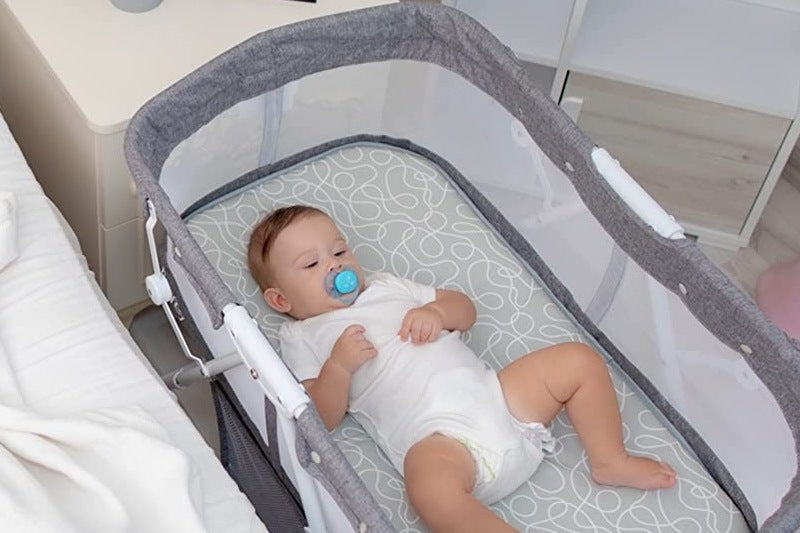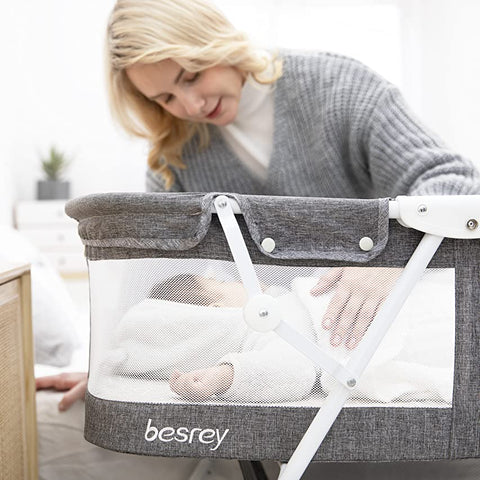
Bassinet Vs Crib: Differences & Which is Better for a Baby?
When the baby is born, he should be given a comfortable and independent sleeping space, as a good night's sleep will aid his growth and development. There are two main types of baby sleep products on the market: bassinets and cribs. However, many parents are unsure which to choose due to some very similar characteristics. Today, we utilize this article to explain the main differences between the two to assist new parents in making better decisions.
What is a Bassinet?
A baby bassinet is a "small bed designed primarily to provide sleeping accommodations for infants supported by freestanding legs, a stationary frame/stand, a wheeled base, or a rocking base, or that can swing relative to a stationary base," according to the CPCS. Of course, other multifunctional cradles that can be attached to a stroller or combined with a playpen are also available.

What is a Crib?
According to the CPCS, a bedside sleeper is a "bed designed to provide sleeping accommodations for an infant and is intended for use in the home, a child care facility, a family child care home, or places of public accommodation affecting commerce." Cribs are a relatively new development designed to confine a standing child; their cage-like design confines the child to the crib. Children between the ages of one and two can climb out of their cribs and are moved to a toddler bed to avoid a dangerous fall while attempting to escape.

Bassinet Vs. Crib: Pros and Cons
Both bassinets and cribs are designed to provide a safe sleeping environment for babies, but they each have their benefits and drawbacks in specific usage scenarios. Before you buy, you must decide which of the two products to buy based on your current needs and the functions of these two products.
Bassinet Pros
Perfect for Small Living Spaces
The bassinet has a smaller sleeping area than the crib, which can provide a stronger womb-like wrapping and allow a baby to adjust before sleeping alone in the crib or bed. Parallelly, a small sleeping area means a smaller size, which is especially important for families with limited bedroom space. The small size of the bassinet can save more valuable living space.
Better Portability
The bassinet is small in both size and weight. This can make moving the bassinet between rooms easier, especially if your baby is sleepy. Some bassinets can even be folded down to a smaller size to fit in your car or store in tighter spaces.
Less Expensive than Cribs
Generally speaking, a bassinet will be a little less expensive than a crib due to differences in size and functionality. But that doesn't mean there will be a worse experience than a crib, so it's a good choice for budget-conscious families.
Bassinet Cons
Weight Limit
Because bassinets are generally smaller than cribs, they use less material and can hold less weight than cribs. As a result, the load-bearing range of the bassinet will be much smaller than that of the crib, which means that once the baby gains weight, new sleeping products, such as cribs, bedside beds, and other products, will be required to adapt to the new sleeping needs of the baby's growth and development.
Not Cost-effective
Although a bassinet is less expensive than a crib, parents must spend money on new sleep products once their child reaches a certain age due to its smaller weight range. As a result, the bassinet is not very cost-effective in the long run.
Crib Pros
Larger Sleeping Area
Cribs are generally larger than bassinets, resulting in a larger sleeping area. A larger sleeping area can provide a more comfortable sleeping environment and give your child more space to move around as they grow in height and weight.
Used Longer
The crib has a larger sleeping area and higher guardrails, so when the baby tries to get up and even climb out of the bassinet, the crib can better limit the baby's movement to protect the baby's safety. This makes the crib appropriate for newborns to older babies and can even be used for years.
Crib Cons
Hard to Move
Cribs are made of more material to stabilize the overall structure, increasing the weight and making movement difficult. As a result, the crib is typically placed in a room corner or beneath a wall. When the baby wants to sleep, the parents can only take them into the crib.
Take up More Space
A larger crib takes up more living space in the room. If you are considering purchasing a crib, you should first determine whether the size of the crib will fit in the room.
What Are the Differences Between Bassinets and Cribs?
As previously stated, bassinets are smaller than cribs; bassinets are available in folding models, but foldable cribs are extremely rare on the market. Furthermore, bassinets typically have a bassinet mode and a rocking mode, allowing you to use the rocking mode to soothe your baby before he falls asleep. In contrast, cribs are typically used only for sleep. Some bassinets have wheels that allow them to be moved between rooms, whereas cribs are typically fixed in only one corner of the room.
Which is Better for Your Baby?
If your baby requires some relaxing time before falling asleep, a bassinet is a better option; the bassinet's rocking mode saves you labor, and you can help your baby fall asleep by simply rocking the bassinet without having to carry your baby around. A crib is better if you want to use a baby sleep product for longer; with a greater load-bearing range and a larger sleeping area, the crib can be used for a longer time as your child grows.
Which One is Safer?
The risk of rollover or other accidents is reduced because the bassinet has a lower center of gravity and a younger age range. While cribs are generally taller, children in the crib are more likely to stand or move, increasing the risk of falling when they attempt to climb out of it. However, regardless of the product used, parents must follow the manufacturer's safety instructions and maintain sufficient vigilance and handling to keep their children safe.
A Word from Besrey
Aside from bassinets and cribs, a new baby sleep product that has recently gained popularity is bedside sleepers. It allows the baby to sleep against the adult's bed, which is convenient for parents to take care of the baby.
To make parenting easier, Besrey has released its latest model of bedside sleeper with 9 adjustable heights. This bedside sleeper is suitable for babies aged 0-6 months and features a cozy, spine-protective 3D memory mattress. It can be adjusted from 30.91" to 39.37" to accommodate different bed heights. It can be easily moved from room to room thanks to its 360-degree casters. It is now available at a favorable price on both Besrey's official website and Amazon store.






